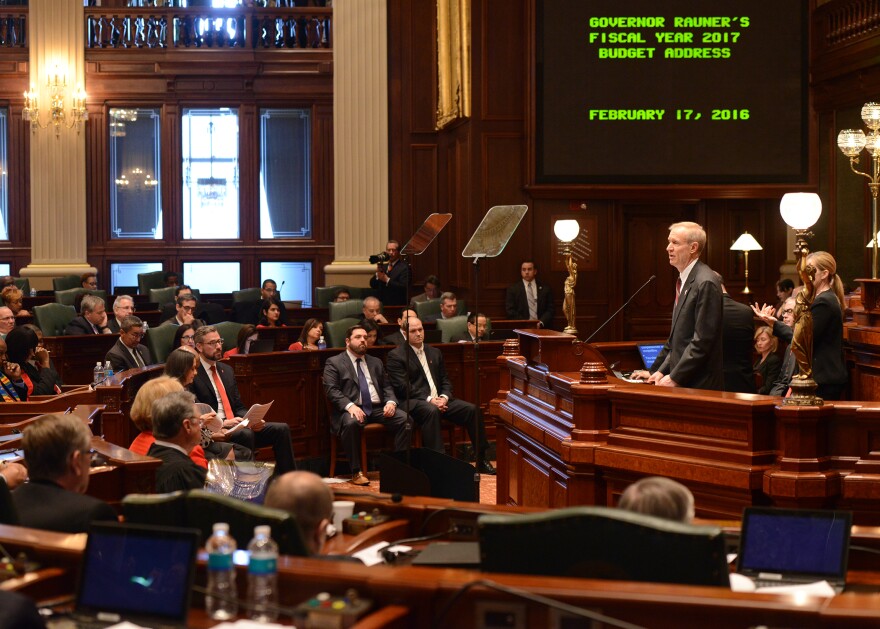The governor's budget address had few specifics about his priorities, or his plans to balance the state's spending with its revenue.
Commentary — When is a budget address not a budget address?
When it’s a well-crafted sales pitch for the policy equivalent of new Coke or the Edsel.
Or, more to the point, when it’s Governor Bruce Rauner’s alleged budget address for FY 2017, which starts July 1.
Since Richard Ogilvie’s first budget message in 1969, every year Illinois governors of both parties have laid out their spending plans for the coming fiscal year, chockfull of numbers — expected new revenues, specific allocations of anticipated resources among myriad of existing state programs, dollars-and-cents earmarked for new initiatives — enough numbers to make one’s head swim.
Not so under the current chief executive. In his 30-minute infomercial for his so-called “Turnaround Agenda,” Rauner mentioned a specific Fiscal Year 2017 dollar amount for only one program — $393 million for early childhood education. He said the $75 million increase from this year’s allocation would keep more than 85,000 children in preschool.
The governor said the early childhood funds would be part of an appropriation for elementary and secondary education that would include enough money to guarantee school districts their full allotment under the state’s school aid formula. But not once did he mention a bottom line for the package, which as introduced also includes the state’s contribution to the pension system covering suburban and downstate teachers.
Granted, backup materials posted online in PDFs and Excel tables spelled out to the nearest $100 how the governor wants to divvy up next year’s money. More about that later. But for now, the governor’s school proposal, embodied in Senate Bill 3234 and House Bill 6335, would cost $14.4 billion, including $10.3 billion in general funds and $3.6 in federal dollars. General state aid would get $4.8 billion, a $141 million hike, while $3.6 billion would go to retirement, some $272 million less than this fiscal year.
Those materials always have been available, in book form back in the day and online in recent years, but governors still routinely cited specific dollar amounts in their budget addresses. Not Rauner.
How much does the governor want for mental health services? For our frail elderly? To assist folks with disabilities reach their full potential? To pay for the state’s prison system? To rebuild our aging roads and bridges? Nary a mention.

No one would disagree with Rauner’s focus on education.
“The greatest investment we can make as a community is in our children,” he told lawmakers. “And the earlier we begin, the bigger the return.”
So perhaps his most surprising omission was any mention of higher education, as Illinois’ public and private colleges and universities began a ninth month with no financial help from the state, jeopardizing the very existence of some schools, starting with Chicago State University, the first of the dominos likely to fall. Officials there recently cancelled spring break in an effort to complete the semester before running out of money and sent layoff notices to all 900 employees, from the university president on down. Eastern Illinois University is planning on laying off almost 200 civil service employees, while everyone else will be required to take as many as 24 furlough days. Western Illinois University announced $20 million in cuts, including reducing personnel by 100 and mandatory furloughs for survivors.
Meantime, bond rating agency Moody’s downgraded EIU’s credit rating to junk bond status and clipped two other schools, Northern Illinois University and Northeastern University, to just one step higher. National higher education accreditation agencies are reviewing the status of all Illinois schools. Loss of accreditation would be fatal, as it would cut off federal help to the schools and financial aid to prospective students.
While the institutions’ plight is shameful, even more deplorable is the fact that thousands of young people from low-income families face losing the opportunity for a college degree because the state scholarship assistance program on which they were counting has yet to be funded.
Maybe, as a wag suggested, the governor figures in his vision of the future Illinois, a high school diploma, with basic reading, writing and arithmetic skills, is all that’ll be needed to hold down a low-paying job in a nonunionized factory while private equity investors line their pockets.
In the real world, however, higher education is one of the state’s greatest strengths, according to a February report by Moody’s Analytics. In listing the positive factors in the long-term outlook for the state, the report cited our world-class universities and our huge talent pool of highly skilled workers. “About 20 percent of the state’s population age 25 and older have a bachelor’s degree, and 13 percent have a graduate degree — both above the national average — according to Census Bureau data,” noted Moody’s.
So why ignore one of the state’s major selling points, or even worse, take an axe to it?
A year ago, Rauner proposed slashing higher education funding by almost a third, some $387 million for the current fiscal year. Democrats cut state colleges and universities by about $47 million in the overall budget they approved last June, but the governor vetoed all but funding for K-12 education, saying the package was $4 billion out of balance.

For the coming fiscal year, Rauner wants to cut total higher education operations, including community colleges and scholarships, by $233 million, roughly 10 percent, from fiscal 2015 levels. Community colleges and scholarship grants would stay at 2015 levels, but institutions would get whacked 20 percent. Still, the overall bottom line would be $2.2 billion more than nothing, which is what schools are getting so far this year.
Such details can be found if one delves deep into the online data — Rauner’s recommendations for higher education, for example, start on page 468 of the 554-page budget book — but past governors would have found room for them in the address, too.
Also noteworthy — though of course not mentioned — was the fact the governor’s plan is almost as unbalanced as the Democratic effort he vetoed last year. His budget anticipates general funds revenues of $32.8 billion and proposes spending $36.3 billion, a $3.5 billion gap between income and outgo.
Not to worry, though. Rauner’s fiscal gurus subtracted $3.5 billion via a budget line dubbed “Working Together or Executive Management.” Presto! Everything balances, just like magic. Never mind the statute requiring governors to propose a budget that reflects actual law at the time, which would seem to preclude such fudge factors.
And that’s where the sales pitch came in.
The governor said he’d be open to raising taxes to help close the gap, but only if Democrats supported “major structural reforms” to grow more jobs and get more value for taxpayers: his “Turnaround Agenda.” The governor ticked off a familiar wish list, starting with business-friendly changes in workers’ compensation and personal injury lawsuit rules, two areas that seem ripe for compromise. He moved on to local government consolidation, also doable. Then came the deal-breakers for Democrats, starting with “mandate relief,” which Raunerites envision not just as cutting red tape, but also severely limiting collective bargaining and eliminating requirements that union wages be paid on public works projects. Rauner’s final point made that explicitly clear, “local control of bargaining and bidding to drive down property taxes.”
If Democrats won’t capitulate, the governor said, they should approve “The Unbalanced Budget Response Act,” a 22-page measure that essentially cedes the legislative branch’s role in crafting a 2017 budget to the executive.

Under the unprecedented power grab, Rauner would have carte blanche to cut spending for any program, except payments to bond holders, general state aid to public schools and early childhood education. He could ignore continuing appropriations — state laws that require payments for items like pension contributions or sending local cities and counties their share of state income tax collections. He also could move money into the general funds from almost all of the state’s 700-plus accounts, with the only exceptions federal funds, debt service, pension system assets and the Road Fund. As a final touch, the governor could slash payment rates and tighten eligibility criteria as he saw fit for all the state’s human services programs, regardless of whatever provisions might now be on the books.
Attempting to sell the idea, he reminded lawmakers they had given emergency budget authority to governors in the past, which is true. Indeed, last spring the legislature authorized borrowing up to $650 million from other accounts, but lawmakers kept off limits funds raised or used by other elected officials, such as fees collected by the secretary of state. The 2015 law also required the borrowing to be repaid with interest, provisions missing from Rauner’s bill.
Despite Rauner’s earnest plea that Democrats choose a path — in blunt terms, either embrace his anti-union agenda or give him dictatorial control of state spending — his pitch seemed to fall on deaf ears. That’s hardly a surprise. No one should expect Democrats would abandon organized labor and not just because they fear retaliation from House Speaker Michael Madigan, as Rauner and his PR minions like to suggest. Anyone could be the speaker, and most Democrats would continue to believe that working men and women should be able to organize to safeguard their workplace interests. It’s in their DNA. In fact, plenty of Republicans share that belief, including the three GOP chief executives who preceded Rauner.
But if the governor was sincere when he later said: “We don’t have to enact every item of our Turnaround Agenda in their current forms,” Madigan, Senate President John Cullerton and other Democrats ought to take him at his word.
Start perhaps with workers’ comp negotiations, marrying benefit changes with insurance company regulation to ensure cost savings are passed on to employers. Move on to revising personal injury lawsuit procedures, for example by limiting plaintiffs’ venue shopping. Give voters more power to combine or eliminate local government bodies that have outlived their usefulness — but don’t get hung up on trying to neuter public employee unions.
Then get to what really needs to be done, revamping the state’s tax structure so that it generates enough revenue each year to pay for what people consistently tell pollsters they want — education, health care, human services and public safety. And, of course, actually enact a budget that authorizes spending on such core programs, including higher education.
As this column noted half a year ago, it’s not rocket science, but rather statesmanship.
Charles N. Wheeler III is director of the Public Affairs Reporting program at the University of Illinois Springfield.
Illinois Issues is in-depth reporting and analysis that takes you beyond the headlines to provide a deeper understanding of our state. Illinois Issues is produced by NPR Illinois in Springfield.






